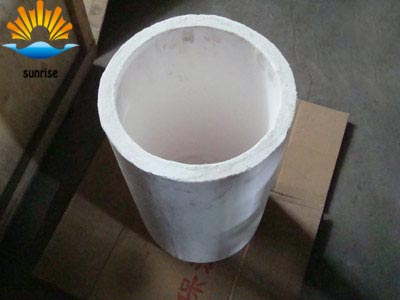 BackNews
BackNews
Analysis on the alteration of fused zirconium corundum brick in glass furnace
2020-04-21 16:41:38In some cases, the pool wall bricks are not a whole block deep, but layered masonry, which has horizontal joints. It is easily eroded at the horizontal joint. Corrosion of fused corundum bricks and sintered anvil bricks is different. The private soil bricks are basically subjected to the same intrusion above and below the horizontal joint, while the wrong corundum brick is severely eroded above the horizontal joint and lightly eroded below the horizontal joint.
Under this upward drilling-like erosion process: there is a gap in the horizontal seam of the pool wall, and the molten glass is easy to take advantage of, and then the brick above the horizontal seam will be eroded by the glass liquid under the head to generate a high anvil degree Floor. The protective layer easily flows downward under the action of gravity. Due to the loss of this high-privacy layer, new brick faces will be exposed to new erosion. At this time, there will be some bubbles at the upper end of the eroded layer, which will increase the erosion.
As a result of this repeated action, the brick above the horizontal joint is eroded by strong upward drilling. However, the protective layer of the bricks under the horizontal joints will not be lost; there are no bubbles staying on the lower surface, so it is less eroded. Now due to the increase in kiln temperature; and the use of auxiliary electric melting and bubbling technology, the erosion above the horizontal joint is more serious. Therefore, the design of the whole pool wall brick is mostly adopted.

Zirconium corundum bricks made in a reducing atmosphere have poor erosion resistance. This is because the electric furnace uses a graphite electrode and a graphite furnace lining to produce a reducing atmosphere. C and CO will reduce part of FeZO3, TiO2, SiO2 in the melt to low-valent oxides, increase the composition, and soften the glass phase in the brick. The temperature will drop from 100 to 150 ° C. When this brick is used at high temperature, the viscosity of the glass phase is low, and it is easier to diffuse into the high-temperature glass liquid, so that the crystal phase in the brick loses the binding and enters the glass liquid, forming stripes and stones.
False corundum bricks produced under a reducing atmosphere will also generate bubbles in the glass. This is because the low-valent oxides and other reducing substances (such as C) in the glass phase of the brick are strongly reducing. When they interact with the glass, they capture the oxygen dissolved in the glass, making the soluble gas in the glass liquid difficult to dissolve. It becomes a bubble. For example, SO3 dissolved in the glass liquid is reduced to become SO2, and the solubility of SO2 in the glass liquid is low, so it becomes bubbles, which reduces the quality of the glass. The zirconium corundum brick made by hydrogenation method can improve its performance and prevent the above defects.

